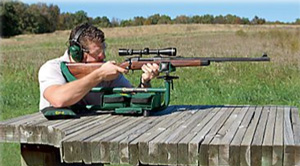
Sighting-in a rifle is fairly simple if you follow a few basic steps outlined in a previous how-to article, How to Sight-In a Rifle. But there are also some tricks I've picked up over the years to help make the process easier.
1. If you are sighting-in a brand new rifle, carefully follow the manufacturer's suggested break-in procedures in order to ensure that the barrel's rifling doesn't become permanently scarred with copper fouling. You'll find that such suggestions vary a bit in terms of how many rounds to fire between scrubbing of the bore.

rifle, but will help to absorb some recoil while
shooting from a bench.
2. Whether you reload or use factory ammo, try to take a few different types of loads with you to the range to see which works best in your gun. Once you've settled on a particular load to use for hunting, save the rest of the test ammo for future use. I like to use them whenever I have to re-sight the same rifle, such as after installing a new rifle scope or after removing the scope or barrel for whatever reason. Rather than starting the whole sighting-in process over again with my hunting ammo, I'll use my non-hunting loads until I get my shots on the target, and then use my hunting loads for fine tuning.
3. There can be differences in the powder, brass and/or primers used between boxes of the same make and model of mass-produced ammo. These differences can cause differences in point of impact. I've personally seen a difference of several inches in point of impact between different lots of the same ammo when fired in the same rifle. When shopping for factory ammo, buy at least two boxes from the same lot number so that you'll have enough for sighting-in and hunting for a while if your rifle ends up showing a liking for that particular ammo. The lot number for each box of ammo is stamped on the inside of each box. I also like to buy fresh ammo for hunting every couple of years, and I'll use the older stuff for practicing.
4. When you are sighting-in for an upcoming trip, try to pick a calm day or at least a day without strong cross winds that can wreak havoc with your groupings. I also like to wait for atmospheric conditions that will be similar to what I'll be hunting in. For instance, if I'm going on a spring bear hunt, I'll go to the range when the weather is nice and mild, rather than during the dead of winter.
5. At the range, a good shooting rest like Caldwell Lead Sled 3 Shooting Rest will not only help to steady your rifle, but will help to absorb some recoil while shooting from a bench. Despite this, don't overdo sessions at the range, especially with heavy-recoiling calibers, as this can lead to flinching. Keep your sessions relatively short, and stop shooting if you start to feel soreness in your shoulder. If you are getting frustrated because you are having some difficulties for whatever reason, such as an inability to get consistent groupings, don't keep banging away in desperation for hours. Call it a day and try to figure out what might be wrong and try again another day.
6. At the range, a good shooting rest like Caldwell Lead Sled 3 Shooting Rest will not only help to steady your rifle, but will help to absorb some recoil while shooting from a bench. Despite this, don't overdo sessions at the range, especially with heavy-recoiling calibers, as this can lead to flinching. Keep your sessions relatively short, and stop shooting if you start to feel soreness in your shoulder. If you are getting frustrated because you are having some difficulties for whatever reason, such as an inability to get consistent groupings, don't keep banging away in desperation for hours. Call it a day and try to figure out what might be wrong and try again another day.
7. When you're at the shooting range, go slow and take your time. Let your rifle cool between shots. A great way to do this is to take two or three guns so you can switch back and forth, with at least one being a low-recoiling caliber such as a .22LR or .22 centerfire rifle.
8. When shooting at a public range, set up several shooting targets to start with so you don't have to constantly wait until everyone else is ready to go downrange to check and change their targets. Investing in a good spotting scope will also save you countless trips downrange to check your results.
9. Everyone's eyes are different, so only you can properly sight-in and set up a rifle for you to hunt with.
10. Once you have your rifle properly sighted-in for an upcoming hunt, especially one that will require your rifle to be transported on a plane, the same boresighter that you used to help you get your first shots on paper at the start of the process can now be used once you get to hunt camp to tell you whether your gun and scope got knocked out of alignment during transit.
One lesson that I've learned the hard way is that even if your boresighter indicates that your rifle and scope are still in the same alignment as when you left home, you should still take a few shots to confirm this once you get to camp. The reality is that unless you sighted-in your rifle at the same elevation you will be hunting at, you may notice a difference in point of impact of several inches as you get higher or lower above sea level. For example, if you sighted-in at or near sea level, you may find that your rifle is shooting higher in the thinner air once you get to camp for your high-altitude sheep or goat hunt.
Good hunting.
- 13970 views

